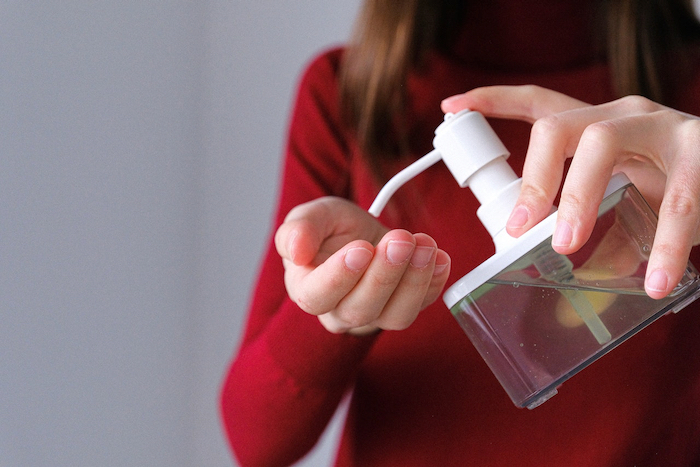
Benzene in skin care products?
You may have heard it on the news: skin care products recalled from the shelves because of benzene.
But just what is benzene? And how does it get into skin care products in the first place?
Benzene in Skin Care Products: What Is Benzene?
Benzene is a colorless, flammable liquid with a sweet odor. Natural processes—such as volcano eruptions and forest fires—create it, but humans also make it to produce a variety of products.
These include materials like plastics, lubricants, rubbers, dyes, detergents, drugs, and pesticides. Benzene is a natural part of crude oil, gasoline (and motor vehicle exhaust), and cigarette smoke.
In the past, it was also used as an industrial solvent and gasoline additive, but these uses have been greatly reduced in recent decades.
Benzene In Skin Care Products: What’s Going On?
Over the recent months, the news media has alerted the public to benzene found in certain personal care products.
It started back in March 2021, when independent analytical lab Valisure detected benzene in hand sanitizers. We were in the midst of the COVID-19 pandemic at the time, and hand sanitizer was in high demand. Due to the emergency, the FDA allowed an interim limit of 2 ppb for benzene only in liquid hand sanitizers.
But of the 260 products Valisure tested, 44 batches (17 percent) contained benzene, with the highest level detected at 16.1 ppm, which was over eight times the interim limit. Valisure submitted a citizen’s petition to the FDA to recall these hand sanitizers and to step up the testing of additional products.
A couple of months later, in May 2021, Valisure again announced that it had found benzene in sunscreen products. The laboratory analyzed 294 unique batches of sunscreens from 69 different companies. They found that these batches varied significantly in their benzene content, even those from within the same company.
Overall, they found 78 sunscreen and after-sun care products (27 percent) contained benzene at higher-than-recommended levels. These included sprays, gels, and lotions with both chemical and mineral-based formulations.
- 14 lots from four different brands contained between 2.78 and 6.26 ppm of benzene.
- 26 lots from 8 brands contained detectable benzene between 0.11 and 1.99 ppm.
- 38 lots from 17 brands contained detectable benzene at <0.1 ppm.
- Benzene was not detected at all in an additional 217 batches of sunscreen from 66 different brands.
Again, the company petitioned the FDA to recall these products, and several recalls followed.
Benzene in Skin Care Products: Dry Shampoos Too!
The most recent study of benzene in personal care products involves dry shampoos. On November 1, 2022, Valisure announced that it had found benzene in 70 percent of dry shampoo product samples tested.
This time, the lab tested 148 unique batches from 34 different brands. Again, they found significant variability between the products—sometimes even from subsequent sprays from some bottles, suggesting inconsistent product mixtures in some products.
The results showed:
- 3 lots from 1 brand contained spray with over 100 ppm benzene
- 11 lots from 3 brands contained spray with detectable benzene over 20 ppm
- 18 lots from 10 brands showed levels between 2 and 20 ppm
- 71 lots from 20 brands contained quantifiable benzene between 0.18 and 2 ppm.
- Benzene was not detected or was below the limit of quantification in an additional 45 lots from 23 different brands.
Valisure noted that benzene in these products was particularly concerning because the products are used indoors, where benzene can linger and be inhaled for long periods. The lab suggested recalls, and Unilever followed up with a recall of 19 popular dry shampoo products including Dove, Nexxus, Suave, BedHead, TRESemmé, and Rockaholic.
Over the past year, benzene has also been detected in deodorants, athlete’s foot treatments, and body sprays.
What are the Health Risks of Benzene?
According to the American Cancer Society (ACS), benzene is a known human carcinogen. That means that scientific studies have found that it can cause cancer in both animals and humans. The strongest link is between benzene and blood cancers like leukemia.
Several other government agencies, including the Environmental Protection Agency (EPA), classify benzene as a “known human carcinogen.”
Human studies have found that workers exposed to high levels of benzene—such as those who work in the chemical, shoemaking, and oil-refining industries—have a higher risk of acute myeloid leukemia (AML).
Laboratory studies have also found that benzene can cause chromosome changes in bone marrow cells (where new blood cells are made). These are the same types of changes that are seen in human leukemia cells.
The International Agency for Research on Cancer (IARC) also notes that benzene exposure has been linked with acute lymphocytic leukemia (ALL), chronic lymphocytic leukemia (CLL), multiple myeloma, and non-Hodgkin lymphoma.
How Are Humans Exposed to Benzene?
You may be exposed to benzene via the air you breathe, the water you drink, the products you use every day, and even the food you eat.
Like with so many chemicals, the danger is in being exposed to benzene at all, but being exposed to too much of it. Trace levels aren’t going to hurt you, but we don’t know yet what the threshold is when we’re talking about daily exposure.
As noted above, workers in industries that make or use benzene are most likely to get too much of it, but federal regulations do limit exposure to benzene in the workplace. The EPA also limits the percentage of benzene allowed in gasoline to an average of 0.62 percent by volume, with a maximum of 1.3 percent.
The EPA further limits concentrations of benzene in drinking water to 5 parts per billion (ppb), with some states having lower limits. The U.S. Food and Drug Administration (FDA) limits it to 5 ppb in bottled water.
The Consumer Product Safety Commission (CPSC) considers any product containing 5 percent or more by weight of benzene to be hazardous, requiring special labeling.
Benzene in Skin Care Products: How Does It Get In There?
The FDA restricts benzene to 2 ppm only in cases where its use in manufacturing is unavoidable and the drug product constitutes a significant therapeutic advance. In all other cases—which includes personal care products like sunscreen—FDA guidance is to avoid benzene altogether.
And most manufacturers do—they don’t add benzene as it’s not needed.
So how does benzene get into these products? Scientists aren’t sure, but usually, it’s present as a by-product—because of other ingredients or the manufacturing process.
FDA scientists think the chemical may come from inactive petroleum-derived ingredients, such as carbomers, a thickening agent, or isobutane, a spray propellant. It could also come from ethanol produced without adequate purity control.
But so far, these are just guesses. It hasn’t been fully determined what the source of the contamination is in these products, and if it’s consistent across all of them.
Benzene in Skin Care Products: Is Benzene Harmful to Skin?
According to the ACS, exposure to benzene liquid or vapor can irritate the skin, eyes, and throat. Skin exposure to benzene can result in irritation, dryness, redness, and blisters.
They’re talking about direct exposure to benzene liquid, however—not the benzene found in personal care products. Typically, the levels in these products won’t harm the skin over the short term. We don’t know, however, how daily, long-term use may affect it.
How You Can Limit Your Exposure to Benzene in Skin Care
To limit your potential exposure to benzene in personal care products, follow these tips:
Avoid those with petroleum-based ingredients.
Because petroleum-based ingredients may be a source of benzene, it’s best to avoid personal care products that contain them. Examples include:
- petrolatum
- mineral oil
- paraffin wax
- PEG
- Toluene
- DEA
- Parabens
- Words with “ethyl” (like polyethylene, ethyl alcohol)
- Words with “butyl” like butylene glycol and butyl alcohol
- Words with “eth” like ceteareth, laureth)
- Propyl-containing substances like isopropyl alcohol, propylene glycol, etc.
Avoid aerosol-based cosmetics.
Spray sunscreens, spray conditioners, and the like all have to be propelled out of a can. This often requires a propellant that may be a benzene-containing ingredient. Until we know more, use alternatives like lotions and creams.
Buy from conscientious companies.
Many personal care companies are very conscious of potential toxins in skin care. Here at CV Skinlabs, for example, we screened every ingredient before including it in our products to be sure it was 100 percent toxin-free. We avoid all petrolatum products, and our Rescue + Relief Spray is not propelled by a chemical, but by a hand-held pump (which requires no chemicals).
Check the Skin Deep Database.
The Skin Deep Database contains information on the ingredients in thousands of products. You can put your product in the search bar to see if it may contain benzene or any other toxic ingredients.
How do you avoid benzene in skin care products?



